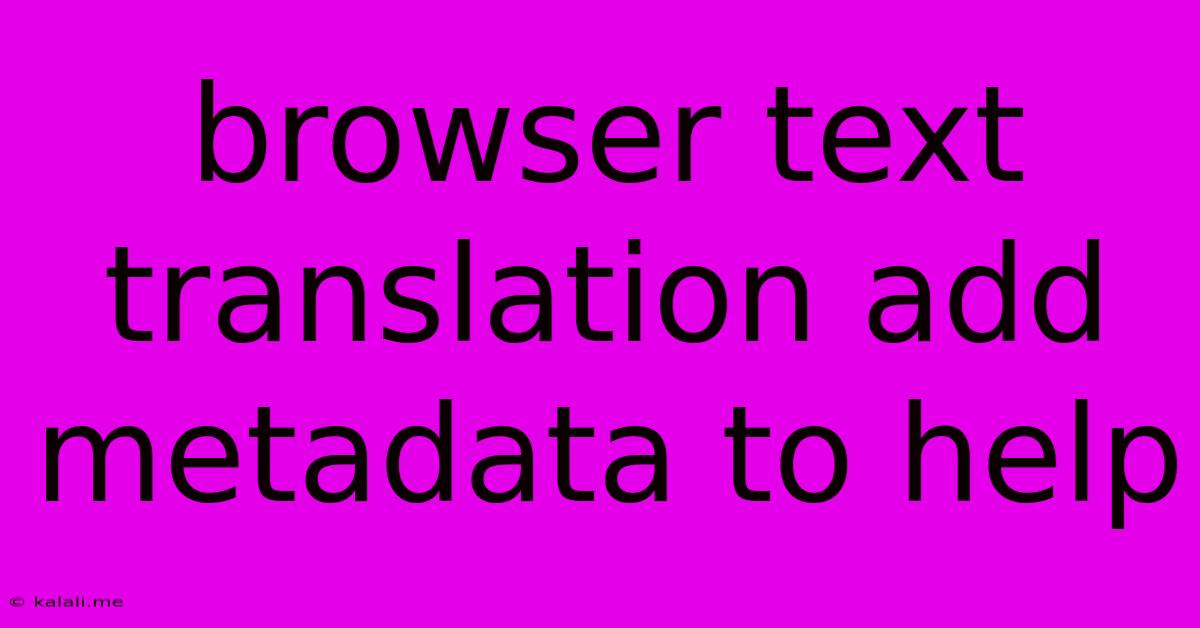Browser Text Translation Add Metadata To Help
Kalali
Jun 03, 2025 · 3 min read

Table of Contents
Browser Text Translation Add Metadata to Help SEO: A Deep Dive
Meta description: Learn how browser text translation tools, while not directly impacting SEO, can indirectly boost your website's visibility by improving accessibility and user experience, leading to increased engagement and potentially higher rankings. This article explores the connection between translation, metadata, and improved SEO.
Search Engine Optimization (SEO) is a multifaceted field, constantly evolving to keep pace with changes in search engine algorithms and user behavior. While factors like keyword density and backlink profiles are crucial, often overlooked aspects can significantly contribute to a website's success. One such area is website accessibility and the role browser text translation tools play, albeit indirectly, in SEO. Although browser translations don't directly add metadata to your website's HTML, they impact user experience in ways that can positively influence your SEO.
Understanding the Limitations of Browser Translation
It's crucial to understand that browser text translation tools don't modify your website's source code or add metadata directly. They operate solely on the client-side, translating the rendered content for the user. This means that Google's crawlers see the original language of your website, not the translated version. Therefore, you shouldn't rely on browser translations to magically expand your website's reach into different languages for SEO purposes.
The Indirect Benefits for SEO
Despite not directly impacting metadata, browser translation tools offer significant indirect benefits that can improve your website's SEO performance:
-
Improved User Experience (UX): A positive user experience is a core ranking factor. Offering easy translation options allows international users to access and understand your content, leading to increased engagement metrics like longer session duration and lower bounce rates. These positive signals can indirectly help improve your website's search ranking.
-
Increased Dwell Time: When users can easily understand your content in their native language, they are more likely to spend more time on your site, exploring various pages and engaging with your material. This increased dwell time is a key indicator of relevance and quality to search engines.
-
Higher Conversion Rates: Improved understanding leads to improved conversions. Whether it's making a purchase, filling out a contact form, or subscribing to a newsletter, users are more likely to take action when they effortlessly comprehend the information presented.
-
Enhanced Content Accessibility: Making your content accessible to a wider audience through translation aligns with Google's focus on providing relevant and inclusive results. While not a direct ranking factor, it showcases a commitment to user accessibility, which can positively affect your overall SEO strategy.
Optimizing for Multilingual SEO: The Right Approach
To truly target international audiences, relying solely on browser translations isn't sufficient. Instead, consider these strategies:
-
Professional Translation: Invest in professional translation of your website's content into the target languages. This ensures accuracy and avoids potential misinterpretations that could negatively affect your brand.
-
Hreflang Tags: Implement hreflang tags in your website's HTML to tell search engines which language version of a page is intended for which country or region. This helps Google deliver the appropriate version of your website to users based on their location and language preferences.
-
Multilingual Metadata: Ensure your metadata (title tags, meta descriptions) is appropriately translated for each language version of your website. This is crucial for targeted SEO in different regions.
Conclusion: Leveraging Browser Translation as a UX Enhancement
Browser text translation tools, while not a direct SEO solution, act as valuable UX enhancements. By improving user experience and accessibility, they indirectly contribute to better SEO performance. However, for true multilingual SEO success, professional translation and appropriate use of hreflang tags and localized metadata remain critical components of a comprehensive strategy. Focusing on delivering a seamless experience across languages is key to reaching a global audience and achieving higher search rankings.
Latest Posts
Latest Posts
-
Alternatives For Book Of Shadows 5e
Jun 04, 2025
-
Dnd Can Faceless Be Someone Hiding Their Race
Jun 04, 2025
-
Best Books On Modern Monetary Theory
Jun 04, 2025
-
Can You Put A Block Heater On A Gas Engine
Jun 04, 2025
-
Three Houses Are Saint Statues Just For Byleth
Jun 04, 2025
Related Post
Thank you for visiting our website which covers about Browser Text Translation Add Metadata To Help . We hope the information provided has been useful to you. Feel free to contact us if you have any questions or need further assistance. See you next time and don't miss to bookmark.